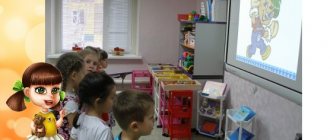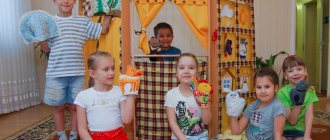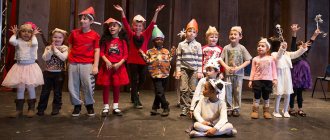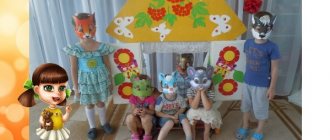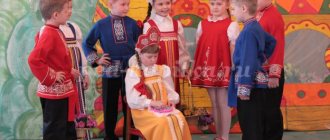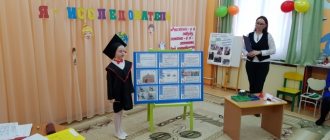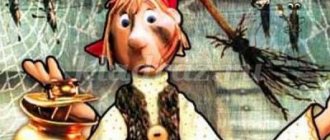Theatrical performance in kindergarten is the goal
Theatricalization is understood as one of the types of play activities used to reveal the deepest creative potential that every child has. When theatricalization, dramatic techniques are used (in other words, role-playing) and various exercises aimed at developing children's acting skills.
A lot depends on the design
For your information. The value of theatricalization lies in the fact that it helps to develop the child’s monologue and dialogic speech and, as a result, improves the level of his communicative abilities.
The theatrical performance includes the following elements:
- improving the expressiveness of characters’ lines;
- development of both active and passive vocabulary;
- work on speech development.
The corner develops thinking
In addition, the use of theatricalization pursues the following goals:
- introduce the child to the world around him;
- promote the development of creative abilities;
- develop the emotional component;
- develop an interest in reading and art;
- develop directing skills;
- learn to embody a character’s character through your own actions.
For your information . Theatrical performance is considered one of the most effective ways to introduce a child to aesthetics, culture and morality.
Theatrical activities in preschool educational institutions
Theatrical activities as a means of developing children's abilities.
Introduction.
Today, teachers are faced with the task of improving traditional methods of preschool education of children and finding new approaches to organizing the educational process.
The formation of communicative competence in future schoolchildren, their preparation for training within the framework of the Federal State Educational Standard of general education is one of the tasks of the educational institution. The main direction in the formation and development of children's communicative competence is theatrical and play activities in kindergarten. It is precisely this that allows a child to develop expressive speech, increase the level of his intellectual culture, raise an aesthetically developed personality, instill a love for his native culture, help everyone feel self-confidence, develop emotional responsiveness in a child, and at the same time has a pronounced healing character. Scientific research and pedagogical practice prove that the development of creative abilities begins in preschool age. At this age, children are extremely inquisitive, they have a great desire to learn about the world around them. The thinking of preschoolers is more free than the thinking of older children. It's more independent. And this quality needs to be developed. Theatrical activities make it possible to develop the experience of social behavior skills because every literary work for preschool children always has a moral orientation (friendship, kindness, honesty, courage). Thanks to theatricalization, the child not only learns about the world, but also expresses his own attitude towards good and evil, and becomes familiar with folklore and national culture. Therefore, the task of introducing children to theatrical activities becomes relevant for teachers of preschool institutions. Goal and objectives The goal of pedagogical activity is to develop the creative abilities of preschool children through theatrical activities. Objectives: • develop a sustainable interest in theatrical and gaming activities; • develop imagination, fantasy, attention, independent thinking; • improve gaming skills and creative independence through theatrical games that develop the creative abilities of preschoolers; • enrich and activate the vocabulary; • develop dialogic and monologue speech; • cultivate humane feelings in children. Methods and techniques for organizing theatrical activities Principles for conducting theatrical activities: - visibility in teaching - is carried out on the perception of visual material (illustrations, video materials, excursions to the theater, musical fragments, theatrical performances by teachers of a children's institution); - accessibility - children's theatrical activities are designed taking into account age characteristics, built on the principle of didactics (from simple to complex); — problematic – aimed at finding solutions to problem situations; — the developmental and educational nature of training is aimed at broadening one’s horizons, at developing patriotic feelings and cognitive processes. Working methods for organizing games - dramatizations: • the method of modeling situations - involves creating model plots, model situations, sketches together with children; • method of creative conversation - involves introducing children to an artistic image through a special formulation of a question, dialogue tactics; • method of associations - makes it possible to awaken the child’s imagination and thinking through associative comparisons and then, based on the emerging associations, create new images in the mind. The general methods of guiding the game - dramatization are direct (the teacher shows the methods of action) and indirect (the teacher encourages the child to act independently) techniques. Rules of dramatization: Rule of individuality. Dramatization is not just a retelling of a fairy tale; it does not have strictly defined roles with pre-learned text. Children worry about their hero, act on his behalf, bringing their own personality to the character. That is why the hero played by one child will be completely different from the hero played by another child. And the same child, playing a second time, can be completely different. Rule of all participation. All children participate in dramatization. If there are not enough roles to portray people and animals, then active participants in the performance can be trees, bushes, the wind, a hut, etc., which can help the heroes of the fairy tale, can interfere, or can convey and enhance the mood of the main characters. Rule of freedom of choice. Each fairy tale is played out repeatedly. It is repeated (but it will be a different fairy tale each time - see the rule of individuality) until each child has played all the roles he wants. Rule of helping questions. To make it easier to play a particular role, after getting acquainted with the fairy tale and before playing it, each role is discussed and “spoken out” with the children. Questions to children help with this: what do you want to do? What's stopping you from doing this? What will help you do this? How does your character feel? What is he like? What does he dream about? What is he trying to say? Feedback rule. After playing the fairy tale, there is a discussion about it: What feelings did you experience during the performance? Whose behavior, whose actions did you like? Why? Who helped you the most in the game? Who do you want to play now? Why? The rule of a wise leader. Compliance and support by the teacher with all the listed rules of dramatization, an individual approach to each child. Types of dramatization: • games-imitation of images of animals, people, literary characters; • role-playing dialogues based on text; • staging of works; • staging performances based on one or more works; • improvisation games with the acting out of a plot (or several plots) without prior preparation. Methods of work: • method of modeling situations - involves creating model plots, model situations, sketches together with children; • method of creative conversation - involves introducing children to an artistic image through a special formulation of a question, dialogue tactics; • method of associations - makes it possible to awaken the child’s imagination and thinking through associative comparisons and then, based on the emerging associations, create new images in the mind. The general methods of guiding the game - dramatization are direct (the teacher shows the methods of action) and indirect (the teacher encourages the child to act independently) techniques. The results of the work on organizing theatrical activities for children in preschool educational institutions include the following: children become more emotional, more mobile; learn to understand art and express their impressions openly and honestly. A child who knows how to create an image on stage, transform and express his emotions becomes an emotional, open, cultural and creative person.
We recommend watching:
Scenario for a puppet theater in kindergarten Scenario for a theater festival based on Pushkin’s fairy tales for older preschoolers Musical-themed fairy tale for older preschoolers with elements of life safety for preschoolers Do-it-yourself shadow theater in kindergarten
Similar articles:
Theatrical performance script for middle school children
Theater corner in kindergarten and its design
The theater corner is a component of the general atmosphere of the group, created with the aim of uniting children and developing new skills and competencies in them.
The classic theatrical corner consists of several components:
- illustrations, photographs, paintings, etc.;
- toys;
- screens (which are used as decorations, as well as curtains);
- additional props (bells, bells, cars);
- decorative elements;
- outfits and masks;
- demonstration stands;
- library sector.
Illustrations and toys are important in the corner
The theater corner should be equipped in such a way as to make theatrical activities effective.
For your information. When designing a theater corner, it is fundamentally important to take into account the age group of children, take into account the group and personal characteristics of children, their interests and aspirations.
Junior group
In nurseries and the first group of kindergarten, it is better to pay attention to finger theater. It requires dolls that fit on each child’s finger and develop fine motor skills well.
Almost any material can be used to make such dolls. It could be fabric, felt, paper, polymer clay.
The next stage, which occurs at the junior group level, is teaching children how to properly play with toys on the table surface, as well as developing finger theater skills. The task of this stage is to train the coordination of the child’s movements and further develop his fine motor skills.
For your information . In order to make such a prop yourself, you will need cones made of hard paper or cardboard. In addition, the use of bibabo (a set of glove puppets) seems advisable at this age.
Children in this age group should do:
- finger theater;
- tabletop theater;
- theater of soft and knitted toys;
- theater of toy-cones.
Middle group
Children need to hone all previously acquired skills, so classes started in previous years should not be interrupted. At the same time, it is necessary to introduce new types of theatricalization. At this stage of child development, the theater of spoons is appropriate. To “cook” the characters in the productions, ordinary plastic utensils are used here. At the same time, the theater screen began to be used.
Card index of games for artistic and aesthetic development
For your information . You can introduce children to dolls on the gapite. Hapit is a wooden rod. These props will help kids learn the basics of puppeteering.
During centralization classes, children in the middle group are given a more complex task. They need to bring their own movements and the plot of the production into agreement. The theater begins to represent an action that has a clear storyline and meaning. This requires the baby to reach a new level of development of coordination and motor skills.
Options for middle group children:
- finger theater;
- tabletop theater;
- dolls on gapits;
- glove puppets.
Senior kindergarten group
During training in the senior group, it is recommended to start using puppets during theatrical classes. These dolls are characterized by an unusual way of bringing them into a state of movement. A special thread holder (cross) is responsible for this process. It is to it from below that the “body” of the toy is directly attached.
In addition, special attention should be paid to the process of voicing the characters, because the goal of theatrical classes at this stage is to teach children to use vocal intonations to convey emotions.
The optimal options are:
- finger theater;
- glove puppets;
- puppets.
In the preparatory group
At this stage, the child already becomes a “real” actor. He must transform into his hero by reproducing his manner of moving, speaking, and behaving. The child must learn to imitate the voice and correctly express the emotions and experiences of the hero. For a more accurate and real transformation, children dress up in stage costumes.
Life-size puppets develop well
At this age, it is possible to use a wide range of props, for example:
- finger puppets;
- changelings;
- glove puppets;
- puppets;
- life-size puppets;
- cane dolls.
At the same time, it is worth taking into account a certain convention of the above distribution of activities in the theater club depending on the age group of the child.
For your information. It is necessary to take into account the general level of the group, the specifics of the child, and the presence of interest in a certain type of theatrical activity.
It is a completely normal practice for children of middle and senior age to participate in costume performances. Glove puppets can be successfully used in theatrical performances even for children 5–6 years old.
Do-it-yourself spoon theater in kindergarten. Step-by-step master class with photos
Master class of a didactic game for theatrical activities based on the fairy tale “Zayushkina’s Hut” for children 4-7 years old
Author: Alexandrina Tatyana Aleksandrovna, teacher of the State Budgetary Educational Institution “School No. 892” Preschool No. 1, Moscow Master class is designed for teachers and parents Purpose : for theatrical activities in kindergarten and at home Purpose: making fairy tale heroes for theatrical activities based on plastic spoons Objectives: • To teach the technology of making fairy tale heroes; • Develop creativity and imagination, fine motor skills; • Foster hard work and accuracy when making crafts
Job description: Play activities are a component of the harmonious all-round development of preschool children. Theater is one of the effective types of play activity in kindergarten. In theatrical activities, children show creative activity, develop abilities, and realize their potential. There are different types of theaters: bench, table, floor, etc. And now non-traditional types are increasingly used: from plates, from capsules from Kinder eggs, on sleeves, on cups, on spoons. Spoon theater is a tabletop type of theatre. As a rule, the basis of tabletop theater is our favorite fairy tales. The children know them very well and love them. Theatrical performances based on fairy tales contribute to the formation of independence, initiative, the ability to distinguish between good and evil, and develop facial expressions, gestures, speech, and communication skills. I propose to make one of the heroes of the fairy tale “Zayushkina’s Hut” for theatrical activities (the rest of the heroes are made by analogy). Such characters will undoubtedly cause delight and surprise in the child. Tools and materials:
- album sheet - fur - scissors - two types of fabric - ruler - simple pencil - threads with a needle - plastic spoon - eyes for needlework - Moment glue - braid - woolen threads
Work progress: Using a ruler, measure the width and length of the pattern and make markings with a piece of soap
Using scissors, cut along the contour
Use a blanket stitch to hem the pattern at the top and bottom.
Sew the side edges of the pattern and jumble the top of the pattern
We draw templates for future patterns on a landscape sheet and cut them out
Transfer the ear and tail templates onto the fur and cut them out
Sew the tail to the back of the pattern
Glue the ears to the back of the spoon
Transfer the eye and nose templates to the fabric and cut them out
Glue the eyes, nose and decorative eyes onto the spoon
We measure and cut two threads from a skein of woolen thread to decorate the mouth, and randomly cut small pieces for the antennae. Glue everything onto a spoon
We put the shirt on the spoon. We wrap the top of the shirt with braid and tie a bow
Our dog is ready
By analogy we make the rest of the fairy tale characters
Later my theater on spoons increased
We recommend watching:
DIY stomp dolls DIY paper hare. Master class with step-by-step photos Crocheted puppet theater. Teremok Summary of the educational situation in the senior group “Making characters for a cone puppet show
Similar articles:
DIY puppet theater. Master Class
DIY puppet theater
An extracurricular event for schoolchildren to combat bad habits. Drug trial
How to make a theater corner passport
The theatrical corner, or rather, its design, must be carried out in accordance with federal state educational standards (abbreviated as Federal State Educational Standards). Designing a theater corner in a kindergarten according to the Federal State Educational Standard requires compliance with certain standards.
The Federal State Educational Standard prescribes that the theatrical corner should provide:
- development of abilities to remember information;
- development of the child’s thought processes;
- development of sociocultural concepts in children;
- strengthening speech capabilities;
- physiological development;
- introduction to a culture of behavior in society;
- knowing yourself as a person.
The passport according to the Federal State Educational Standard includes eight positions. At the same time, the standard provides a detailed description of each of them:
- The inscription of the full name of the child care institution.
- Designation of the group and name of the theatrical corner.
- The authors who designed the corner.
- Name and description of zones that are part of the project. Mandatory elements are a screen and a wardrobe. Zoning of other parts occurs at the discretion of competent persons. In total, we can highlight a costume room, a dressing room, a workshop, an auditorium, a library (including the availability of video and audio materials), a screen, cabinets for storing props, and an area dedicated to the results and achievements of children in the field of theatrical performance (stand).
- Occupancy of each of the existing zones.
- Age indicators of pupils.
- A list of activities that are implemented at a specific age stage during theatrical classes.
- Various methodological developments, recommendations, templates and presentations. They mean advice regarding the frequency of appropriate activities and their duration. It also includes tasks assigned to a specific group, a list of exercises that are required to be performed during theatrical classes for representatives of a specific group.
Drawing lessons in middle groups of kindergarten

